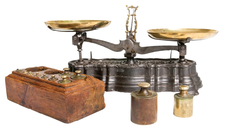An introduction to electronic weighing
Weighing In

© Lead Image © Carlos Velayos, 123RF.com
Create your own weighing device with easily available components and open source software.
In this article, I discuss the design of a compact and portable workshop balance for various single-load-cell weighing applications constructed with a small load cell, an instrumentation amplifier, an excitation supply, a microcontroller, a display, and a serial port for debugging. Throughout, I used Linux and open source software, and I provide code samples, with directions for finding the complete code online.
History
Ancient civilizations used simple balances to compare weights for trading in precious metals, spices, salt, and the like. Today's civilization is no less dependent on knowing the weight of objects. It is hard to imagine a day in which the knowledge of weight does not take part: from the morning visit to the bathroom scales, a trip to the supermarket, baking a cake, to weighing baggage at the airport – the list of times weight plays a part in our lives seems endless. Today, we've moved away from mechanical balances, for the most part, obviating the need for ready reference weights.
Today's weighing equipment is usually based on electronic signals from strain gauges. These sensors are thin-film resistors whose resistance varies in response to tension or compression. When bonded to a mechanical structure subject to the force of an applied mass, the resistance of a strain gauge will change proportionally in response. Practical weighing systems use more than one strain gauge, and these are generally bonded to a metallic billet in a controlled manner to form a more complex electrical circuit designed to eliminate nonlinearities and temperature effects. These billets are known as load cells and are available commercially with working ranges from a few grams to hundreds of tonnes.
[...]
Buy this article as PDF
(incl. VAT)
Buy Linux Magazine
Subscribe to our Linux Newsletters
Find Linux and Open Source Jobs
Subscribe to our ADMIN Newsletters
Support Our Work
Linux Magazine content is made possible with support from readers like you. Please consider contributing when you’ve found an article to be beneficial.

News
-
Parrot OS Switches to KDE Plasma Desktop
Yet another distro is making the move to the KDE Plasma desktop.
-
TUXEDO Announces Gemini 17
TUXEDO Computers has released the fourth generation of its Gemini laptop with plenty of updates.
-
Two New Distros Adopt Enlightenment
MX Moksha and AV Linux 25 join ranks with Bodhi Linux and embrace the Enlightenment desktop.
-
Solus Linux 4.8 Removes Python 2
Solus Linux 4.8 has been released with the latest Linux kernel, updated desktops, and a key removal.
-
Zorin OS 18 Hits over a Million Downloads
If you doubt Linux isn't gaining popularity, you only have to look at Zorin OS's download numbers.
-
TUXEDO Computers Scraps Snapdragon X1E-Based Laptop
Due to issues with a Snapdragon CPU, TUXEDO Computers has cancelled its plans to release a laptop based on this elite hardware.
-
Debian Unleashes Debian Libre Live
Debian Libre Live keeps your machine free of proprietary software.
-
Valve Announces Pending Release of Steam Machine
Shout it to the heavens: Steam Machine, powered by Linux, is set to arrive in 2026.
-
Happy Birthday, ADMIN Magazine!
ADMIN is celebrating its 15th anniversary with issue #90.
-
Another Linux Malware Discovered
Russian hackers use Hyper-V to hide malware within Linux virtual machines.

